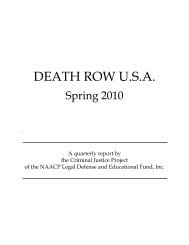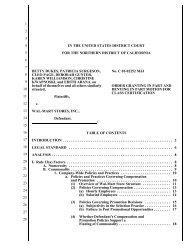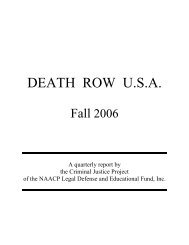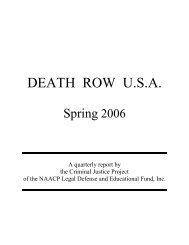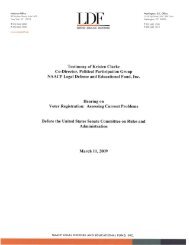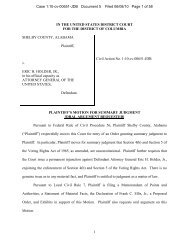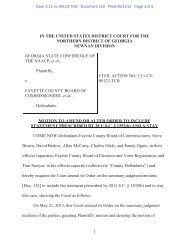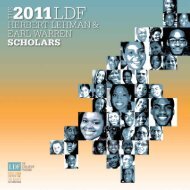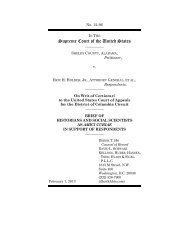Appendices.pdf - NAACP Legal Defense and Educational Fund, Inc.
Appendices.pdf - NAACP Legal Defense and Educational Fund, Inc.
Appendices.pdf - NAACP Legal Defense and Educational Fund, Inc.
You also want an ePaper? Increase the reach of your titles
YUMPU automatically turns print PDFs into web optimized ePapers that Google loves.
Specific Strategies u u u <br />
Verbal<br />
be ruled out because N also appears in the second sentence,<br />
<strong>and</strong> W also appears in the first sentence.<br />
In Question 2, the letter V appears in the second <strong>and</strong> third<br />
sentences, but not in the first <strong>and</strong> fourth sentences. Find a<br />
word that also appears only in the second <strong>and</strong> third sentences.<br />
The word is “cars,” which is Option H. The other options cannot<br />
be correct. The letter V appears in the same position as<br />
“draws” in the second sentence <strong>and</strong> “paints” in the third sentence,<br />
but that does not mean it represents either word. In<br />
fact, the word “draws” also appears in the fourth sentence, <strong>and</strong><br />
“paints” also appears in the first sentence, so neither word can<br />
be represented by the letter V. The word “<strong>and</strong>” (Option J)<br />
appears in all four sentences, so it can be ruled out. The word<br />
“planes” appears in the first <strong>and</strong> third sentences, so the letter V<br />
cannot represent that word.<br />
u u u reading<br />
This section measures your ability to read <strong>and</strong> comprehend<br />
English prose. There are five passages with six<br />
questions each. Each passage is 400 to 500 words long.<br />
The subjects include short biographies, discussions of historical<br />
events, descriptions of scientific phenomena, brief essays on art<br />
or music, discussions with a point of view, <strong>and</strong> human interest<br />
stories. There are no fictional passages.<br />
For each passage, one question will always assess your<br />
underst<strong>and</strong>ing of the main idea of the passage. Other<br />
questions will ask about factual details <strong>and</strong> inferences that<br />
can be drawn.<br />
You may read the questions first, but do not attempt to answer<br />
the questions without reading the passage. It is also unwise to<br />
Example 5<br />
5<br />
10<br />
15<br />
20<br />
25<br />
30<br />
Mary Cassatt defied tradition, family, <strong>and</strong><br />
public opinion to become one of the most<br />
celebrated artists of the United States.<br />
Born in 1845, the daughter of a wealthy<br />
Pittsburgh banker, Cassatt spent several<br />
years of her childhood with her family in<br />
Europe. As she grew older, she gave up a<br />
life of ease to choose a path that at the time<br />
was almost impossible for a woman to<br />
follow. In 1861, while many of her friends<br />
were entering the social world of the upper<br />
classes, Cassatt was beginning her studies<br />
at the Pennsylvania Academy of Fine Arts.<br />
After four years, however, she felt stifled by<br />
the rigid curriculum. Against her father’s<br />
wishes, she decided to return to Europe to<br />
study painting.<br />
Cassatt spent several years, mainly in<br />
France <strong>and</strong> Italy, immersing herself in the<br />
works of great European painters of the<br />
past. Finally, in 1872, she settled in Paris<br />
permanently. There, Cassatt came to admire<br />
the work of the French Impression ists, a<br />
group of “outsiders” that included Degas,<br />
Monet, <strong>and</strong> Renoir. Unlike mainstream<br />
artists who produced the dark, polished,<br />
<strong>and</strong> detailed paintings favored by traditionalists<br />
<strong>and</strong> critics, these artistic revolutionaries<br />
applied pigment to the canvas in small dabs<br />
of pure color to achieve an illusion of light.<br />
Works painted in this manner presented not<br />
5<br />
10<br />
15<br />
20<br />
25<br />
30<br />
35<br />
40<br />
45<br />
50<br />
55<br />
60<br />
photograph-like detail but a softer focus that<br />
conveyed a highly personalized impression.<br />
This new movement inspired Cassatt.<br />
Discarding the traditional European style,<br />
she adopted the luminous tones of the<br />
impressionists. Particularly interested in<br />
the human figure, Cassatt began creating<br />
pastels of groups of women—on outings in<br />
the park, having tea, <strong>and</strong> so forth. In 1879,<br />
Edgar Degas invited her to exhibit with the<br />
impressionists, <strong>and</strong> her paintings were<br />
included in four of their next five shows.<br />
Cassatt <strong>and</strong> Degas admired each other’s<br />
work <strong>and</strong> a loyal friendship developed. It<br />
was Degas who first suggested the motherchild<br />
theme that became the hallmark of<br />
Cassatt’s later work.<br />
Throughout her years in Europe, Cassatt<br />
kept in touch with her wealthy friends in<br />
the United States, introducing them to<br />
impressionist art. Many of the excellent<br />
collections of impressionist paintings in this<br />
country are to a great extent the result of<br />
her influence. As a woman <strong>and</strong> as an<br />
American, Cassatt stood virtually alone<br />
among the impressionist painters. Since<br />
her death in 1926, the work of the<br />
“Impressionist from Pennsylvania” has<br />
been avidly sought by collectors.<br />
35<br />
40<br />
45<br />
50<br />
55<br />
60<br />
23



